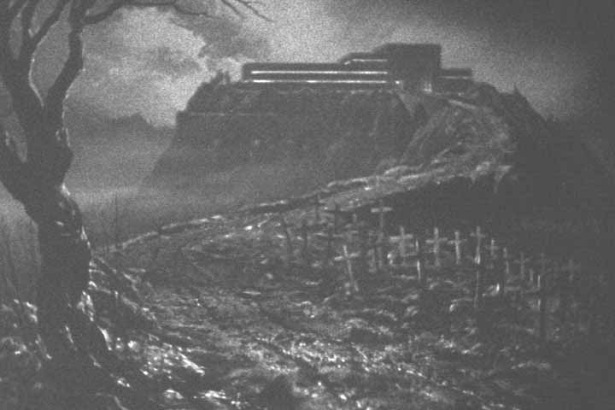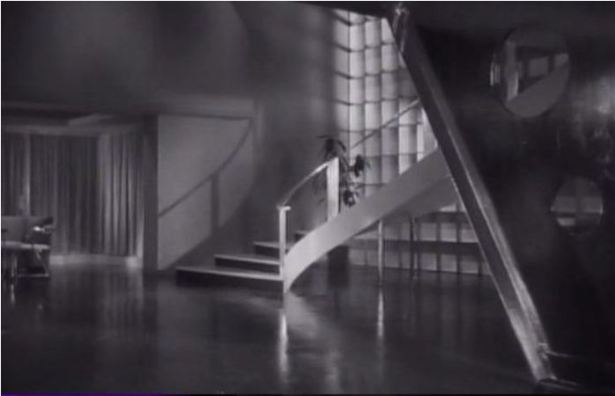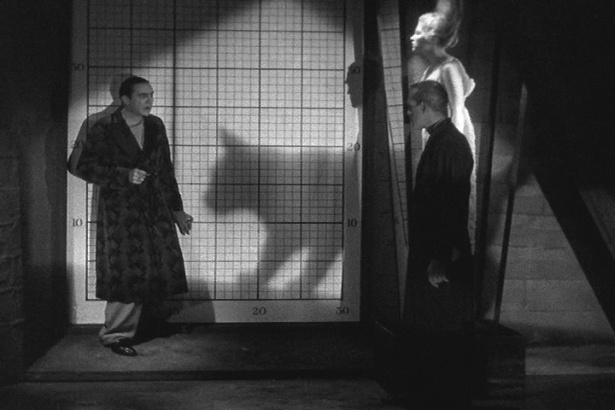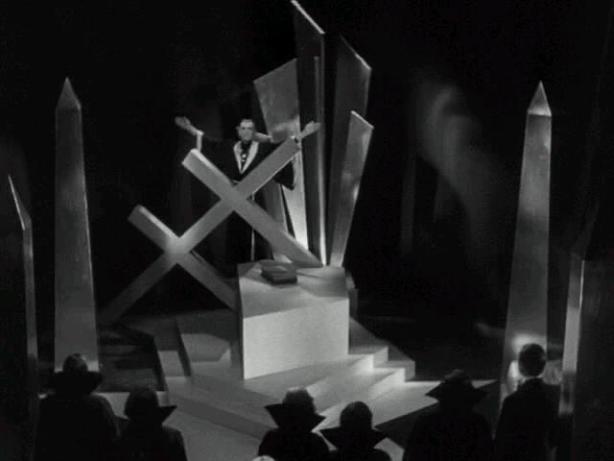The October Country is full of grief, fear, and tragedy, but also of peace, revenge, and justice. What is lost may be found, even if it’s love beyond the grave. Tonight we have a special one: The Black Cat!
In 1934, Bela Lugosi and Boris Karloff were unquestionable stars, already icons of horror. It would be almost a decade more before Universal started pitting its famous monsters against each other, but this is where for the first time the two titans of the macabre went head to head, two sinister screen presences facing off in one of the weirdest and darkest films Universal put out, one that shares very little more than a name with the Edgar Allan Poe story that purportedly inspired it, but one that taps into a vein of dread, menace, and obsession that feels very much in Poe’s wheelhouse.
Edgar G. Ulmer directs, with a screenplay by champion pulp writer Peter Ruric, and they open in a bustling train station with a happy young American married couple off on a Hungarian honeymoon, everything all very nice and charming. Then the conductor announces that a mixup has led to a space in their private compartment being sold to another gentleman, and that’s when Bela Lugosi walks in and immediately tilts them onto a sinister course. Bela plays Dr. Vitus Verdegast, a grim, haunted man returning home after fifteen years in a gulag, where he landed after being captured in the Great War. He speaks ominously of a lost wife left behind, and an old friend he means to visit, reaching out to almost stroke the hair of the sleeping bride in a distinctly disturbing manner.
But it’s the rain-slick mountain roads and inattentive gossipy bus driver that leads them into tragedy. There is an accident. She is hurt. They must find shelter and seek aid, and there is one place where they may do so: the home of Hjalmar Poelzig, the man Verdegast has come to see, a home built atop the ruins of the fort Poelzig commanded in the war.
And here’s where things get really interesting. This is, of course, a spooky manor house perched atop an ominous hill. But the interior is no gothic ruin, but a strikingly modern set. It’s all clean geometric lines and curves, brightly lit and immaculately clean.



Karloff’s introduction is beautiful. A marvelous futuristic intercom lets him know Verdegast has arrived, as he lies in a veiled bed next to a slumbering blonde woman, and Karloff rises, fisible only in silhouette, his unmistakeable profile stark and severe. When he emerges into the light, to meet his guests, he is wearing a severe black dressing gown, his hair styled in a forceful widow’s peak, his eyebrows flaring diabolically. When he comes face to face with Verdegast, the tension between them is instantly palpable. He’s a character modeled in no small part upon Aleister Crowley, infused with a powerfully sinister presence by Karloff.
In private Verdegast accuses Poelzig of the murder of ten thousand men, accuses him of deliberately losing the fort and causing the subsequent death and destruction. That’s what led Verdegast to be imprisoned, and now that he’s free, he’s come back for revenge, but above that, to find and reclaim his wife and daughter, for he’s learned that Poelzig told them Verdegast was dead, and took them to America, before at last returning to build a masterpiece of construction upon the fort he lost.
The confrontation is interrupted by the arrival of the mild-mannered American husband, and then it’s all courteous introductions. Peter Alison writes mysteries. Dr. Verdegast was one of Hungary’s most prominent psychiatrists, and Poelzig, a brilliant architect. The tension recedes, but only slightly, and only for a moment, for we suddenly see the shadow of a black cat walking past the doorway, and it fills Verdegast with spectacular horror, driving him to lash out and kill it with a thrown knife. A common phobia, in extreme measure, as Poelzig explains to Joan Alison when she drifts into the room like a somnambulist. She seems to be oddly affected by the dose of hyoscine Verdegast gave her, and Poelzig in turn seems oddly affected, even enraged, by the sight of her husband embracing her, though he conceals his reaction from his guests.
It’s worth noting that this is one of the earliest talkies to have a persistent musical score, with classical music from Chopin, Liszt, and Tchaikovsky persisting throughout every scene, adding to the sense that this movie never relents.
Certainly it never stops ratcheting up the eerie strangeness. We go straight from Verdegast and Alison retiring for the night to Poelzig pacing through a strange modernist mausoleum full of seemingly dead preserved women in glass cases, a second black cat held in his arms. So much in this film feels like a dream, a feeling amplified by the untraditional set design. These things would feel more normal in a spooky castle, but here, the strangeness feels overwhelming.
At last, Poelzig acquiesces to Verdegast’s demand and reveals the fate of his wife. He leads his old friend down the spiral staircase that leads to the ruins of the old fort, down to the chart room, where Verdegast’s long-lost love is preserved under glass. She died years ago, Poelzig claims, and he kept her thus for he could not bear to be parted.

The way Poelzig mocks and undercuts Verdegast’s gothic quest for vengeance is fascinating. The sinister architect takes the wind out of his enemy’s sails, and sends him to bed.
He then retires to his own room, and there we learn the identity of the blonde woman: Verdegast’s daughter Karen, seemingly under Poelzig’s sway altogether. We also see Poelzig consulting a book on the rites of Lucifer, in particular a passage involving human sacrifice.
Verdegast has secrets of his own, however. In his room we see that he has his servant as a ready aide, his accomplice in the quest for vengeance. We also learn that the whole place is rigged with a whole lot of dynamite.
The stakes thus established, the next morning the two grim men make a wager: for the lives of the Americans, one game of chess. If Verdegast wins, the Alisons may go free. If Poelzig wins, he will proceed to do…well, whatever it is he intends to do.
Peter Alison has, at this point, realized it’s time to get out of dodge. There is no car. The telephone is out of commission. His pistol has been removed from their baggage. And, downstairs, Poelzig declares checkmate. The sinister servant swiftly subdues the stalwart young American, and carries the unconscious bride back up the stairs. The stage is set for a final act where things really get buck wild.
Poelzig sets the mood by sitting down at an organ and hammering out Bach’s Toccata and Fugue in D Minor. Verdegast, meanwhile, seizes his opportunity to have a word with the captive American woman. She is, understandably, freaked out by recent events, and it doesn’t help much when Verdegast tells her Poelzig is the high priest of a satanic cult planning to sacrifice her in the dark of the moon that very night. Her day gets even weirder when she meets the lady of the house, Karen Poelzig, nee Verdegast. She thinks her father is dead, and also doesn’t seem to think there’s anything at all weird about being married to her creepy stepfather.
That night, the cult assembles. In black robes they gather at the strangest satanic altar in movie history, serenaded by eerie organ music as the sacrificial offering is brought in struggling.

A series of unnerving close-ups of the faces of the unnamed cultists and some ominous latin chanting from Poelzig set the mood. On the sidelines, Verdegast and his servant watch and wait.
Meanwhile, in the bowels of the ruined fort, Peter Alison is conscious and looking for a way out.
Everything comes together in an explosion of overwrought gothic melodrama; screaming, strangling, dripping blood, shackles, and the most memorably nasty death in Universal’s canon: Dr. Verdegast’s revenge comes in the form of skinning Poelzig alive, piece by piece. They don’t actually show any of it, of course, but the suggestion is potent enough. This is a movie that literally climaxes with one of the top-billed stars flaying the other top-billed star with a surgical scalpel, and I cannot think of many other films you can describe that way.
After the skinning, the gunshots, and the throwing of giant switches has concluded, the two young lovers make their escape as the whole works collapses in a series of explosions. It’s strong stuff.
Not the most iconic film in the collection, certainly. But it may be the wildest, weirdest, craziest, and most intense. Film critics at the time weren’t necessarily on board with it, but it was Universal’s biggest hit of 1934, and it’s gone on to be a movie that will almost certainly mess you up if you catch it on TV late at night while you’re a kid. That’s how you get guys like Joe Dante and John Landis. This is a movie that deserves to be recognized as a crown jewel of the careers of both Karloff and Lugosi, one of Universal’s greatest masterpieces.

One thought on “The October Country Report #12: Edgar Ulmer’s The Black Cat”